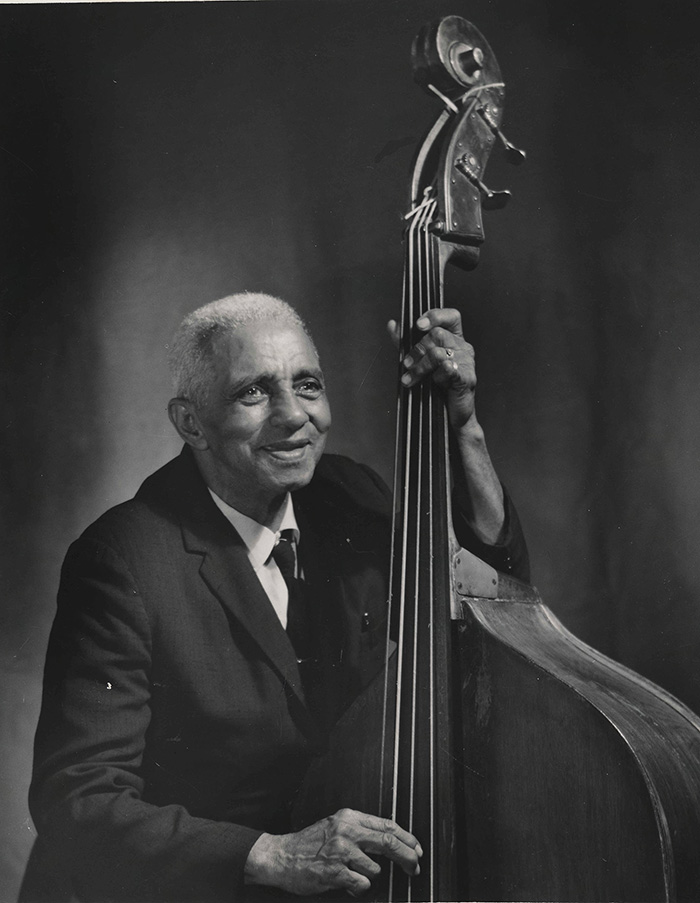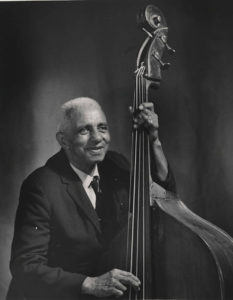Alcide Pavageau
Alcide "Slow Drag" Pavageau was an early jazz guitarist, string bassist, and dancer from New Orleans.

Courtesy of Louisiana State Museum.
Alcide Pavageau, an accomplished bass player and a regular at Preservation Hall in New Orleans, also excelled at dance competitions. He acquired the nickname "Slow Drag" after the ragtime-era dance of the same name.
Alcide “Slow Drag” Pavageau was an early jazz guitarist, string bassist, and dancer from New Orleans. A popular figure with a larger-than-life personality, Pavageau is often said to have been the most photographed musician at Preservation Hall during the 1960s. As one writer at the time noted, “He does so many interesting things that everyone who has a camera wants his picture.” A gifted stringed instrument player internationally recognized for his bass playing, Pavageau was also a talented dancer (hence his nickname, “Slow Drag,” after the Ragtime-era dance). He was also a second line grand marshal, serving in this capacity for the Eureka Brass Band and others. Pavageau’s musical talents can best be heard on recordings he made with Bunk Johnson and George Lewis in the 1940s and 1950s, respectively.
Pavageau was born on March 7, 1888, in New Orleans. The Pavageaus were a musical family and related to many other musicians in New Orleans. Pavageau began learning guitar in 1906 with musical tutoring from his multi-instrumentalist father—who also worked as a cigar maker—and lessons from his cousin, Ulysses Picou. Other relatives included cousin Alphonse Picou, a famous clarinet player, and the musically-inclined Tio and Piron families, including band leader and music publisher Armand Piron. These men and their forebears had traveled and played music in Mexico, Cuba, and Haiti and incorporated Afro-Latin influences into their songs.
Pavageau’s first public gigs were with a band that busked on Basin Street and played for dances and parties in the area. Pavageau also made a name for himself as a champion at dance competitions held in New Orleans community dance halls, where he showed off his talents at the reigning dances of the era. Pavageau’s wife, known as Sister Annie Pavageau, was a gospel-oriented pianist and vocalist.
Around 1928, when Pavageau was in his late thirties, he fashioned his own three-string bass and learned to play it. However, Pavageau never did learn how to tune a bass properly, which became a source of complaint later when he performed with Bunk Johnson’s band. Pavageau began playing bass with Emile Barnes, Buddy Petit, and Herb Morand. In the early 1940s Pavageau started with clarinetist George Lewis, creating a musical partnership that would last throughout the remainder of his career. In 1945 Pavageau traveled to New York and was a player in the well-known 1945 Bunk Johnson New York sessions. In 1958 he toured the United States and Europe with Lewis. Beginning in 1961 Pavageau served as grand marshal for the Eureka Brass Band, a position he would hold until his death.
At Preservation Hall Pavageau played with a number of groups, including those led by Johnny Wiggs, Lewis, “Sweet” Emma Barrett, and Punch Miller. He recorded dozens of times during his long career, including with Kid Thomas (1954), Louis Cottrell Jr. (1961), Kid Sheik (1961 and 1963), Kid Howard (1963), and Percy Humphrey (1965). Many jazz scholars have noted that Pavageau’s percussive bass lines played a primary role in keeping Lewis’s famed rhythm section a consistently driving force.
Pavageau died on January 19, 1969, in New Orleans.
